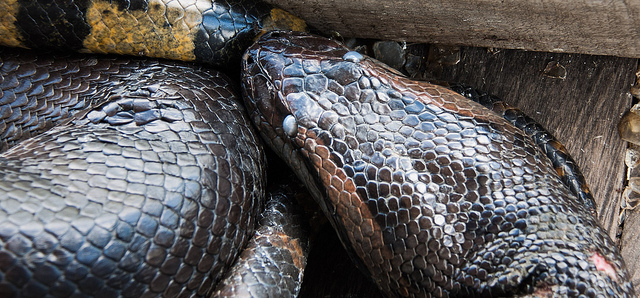

Even after the people in this video freed the snake its belly was floating on the surface because it was so engorged from whatever was in there (possibly capybara or a jaguar). This snake swallowed unidentified prey that’s so big the snake’s belly is swollen to the point that it got stuck in the jungle. Recent footage of an anaconda has gone viral and you’ll soon see why. Then, of course, then you have the prehistoric bad boy Titanoboa which was 42 feet in length and an enormous 2,500 pounds. They can regularly grow over 17 feet but there have been unsubstantiated claims of 30 to 40-foot-long snakes out there. These snakes are the biggest snakes known to man in a length-to-weight ratio, but the longest snake in the world is the reticulated python at 30 feet long sometimes. The green anaconda is the largest snake species no the planet by weight and the 2nd largest by length. Everyone everywhere agrees the anaconda is one of the biggest snakes around. Learn 10 Facts about these huge snakes as they are one of the largest snakes in the world.Subscri. Then there’s the Green Anaconda, one of the biggest and heaviest snake species on the entire planet. Giant green anaconda is the heaviest snake on planet earth. To an adult, a tiny rattlesnake could seem ‘big’ because (1) they’re terrifying to many people and (2) most people run when they hear the rattle and never get a good look at the snake to begin with. To a toddler, a two-foot-long corn snake would be massive.

From the size of the 1.14-tonne Titanoboa, scientists have estimated the average annual temperature in the tropical jungle it inhabited 60 million years ago at 30-34 degrees Celsius (86-93 degrees Farenheit).

"This temperature estimate is much hotter than modern temperatures in tropical rainforests anywhere in the world," said Carlos Jaramillo, Smithsonian staff scientist and co-organizer of the excavations in Colombia. "That means that tropical rainforests could exist at temperatures 3-4 degrees Celsius hotter than modern tropical rainforests experience," he added, alluding to scientific theories that would have tropical forests disappear if global warming boosts temperatures by that measure in the future. The size and weight of Titanoboa - its name is derived from its current descendant, the boa constrictor - was determined by comparing its fossil vertebrae to the radius-to-length ratio of living snakes. The previous snake size record was held by a python that measured 10 meters (33 feet) and weighed (403 pounds), the Smithsonian said. The latest fossils were found inside the Cerrejon coal mine, in Colombia's northeastern region of Guajira.


 0 kommentar(er)
0 kommentar(er)
